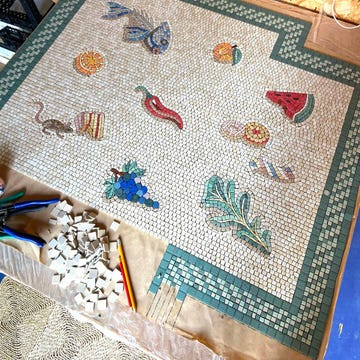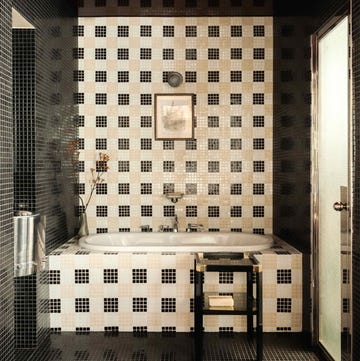Open shelving 2.0
Recently, a rise in the demand for purpose-built pantries and a renewed love of Welsh dressers and other pieces of kitchen furniture once thought a tad traditional might have suggested that our tastes are changing when it comes to storage. There were whispers that our collective obsession with open shelving was waning – perhaps it was an inevitable consequence of all that dusting required to keep glassware and crockery clean? – but we are here to inform you that rumours of its demise have been greatly exaggerated.
A new iteration of the open-shelving trend is emerging. One that champions the art of display and offers new ways to spotlight beloved objects, but also approaches storage as more than purely decorative, integrating it into new parts of the kitchen to improve functionality or the flow of the space.
In her latest project (pictured top), working on the renovation of a home in Islington, Irenie Cossey, founder of Irenie Studio, chose to open up the front of the blue-stained wooden cabinetry that connects its kitchen to the rest of the open-plan dining area, creating a wraparound shelving area that, she says, ‘quietens the space and prevents the kitchen area from feeling too functional’.
What's everyone reading?
Instead, she explains, ‘the shelving becomes the hero moment. It allows the kitchen to become a space for personal curation.’
It’s an approach also favoured by Jäll & Tofta, a German design studio that creates bright, playful kitchens. Its co-founders Sina Gwosdzik and Jakob Dannenfeldt agree that open shelving is the best way to ‘bring more personality into a primarily functional room’, but they also share a more pragmatic reason for including it on an kitchen island in a recent design – ‘We like to work with rounded corners and, as closed curves are more expensive to realise by a carpenter than open ones, we opted to add shelving.’
The sides of an island aren’t the only place to find modern takes on open shelving, though. Architectural designer Stef Claes built up from the island in a recently completed kitchen, creating a slim but effective room divider. Since the storage is open, he claims ‘it encourages a clean, organised approach’.
Sold once again on open shelving, how do you decide what to display? Claes argues for balance: ‘Leave some empty spaces while filling others; play with depth by layering objects, placing some items at the back and others in front, and mix smaller and larger pieces. The beauty comes from contrasts, much like in life.’ Cossey agrees that these are places to add those ‘elements of surprise and personality,’ so keep pots, pans and everyday appliances elsewhere, stash jars and pasta and grains in a purpose-built larder, and consider the role colour can play. Group objects based on complementary tones, or use the shelving itself as a colour-pop moment to champion your favourite pieces – the red shelves in Lyon-based Craie Craie’s Dedieu project (above) are a great example of this.
Shrinking islands
‘The kitchen island has had different meanings throughout history, transitioning from a service piece (a modest table hidden in the kitchens of large houses, reserved for domestic staff) to an emblem of the modern home,’ says architect and designer Ismael Medina Manzano. ‘But now it must stop being a static piece, a symbol of luxury, and become something entirely different: an inclusive device, adapted to the domestic challenges of the contemporary world.’
In times when living spaces are becoming more compact and needing to be ever more multifunctional, he argues that the monolithic islands we have all grown accustomed to can feel ‘unnecessary’. For Unplanned Domestic Prototype, a home Manzano created for a client who shared his design beliefs, he created the ‘Pluriverse Table’ – able to function as a kitchen island, dining table or makeshift desk it can ‘expand, contract, change heights and move around’. Accessible to everyone, including people with disabilities or reduced mobility, it ‘becomes a bridge to connect people, not a barrier that separates them’.
This idea of the kitchen island as a place for people to come together is one that many designers cite as its most important purpose in the modern home – a task that it can perform at any size.
‘To enhance the feeling of gathering and union, we try to include into the island the kitchen equipment we spend most of the time using while cooking, such as the stove and the sink,’ explain João da Silva and Pep Ruiz of Ojjo Studio. In their home studio, a compact island made of marble and wood conceals a flush hob and a foldable tap that can be disguised beneath a matching stone slab to create a seamless ‘floating’ effect.
For American interior designer David Frazier, islands are the ‘workhorses’ of the kitchen, but their practical qualities (offering extra food-preparation space and storage) are equalled by the social function they fulfill – ‘They define the circulation of a space and allow people a place to land – somewhere to perch and congregate.’ In the home he designed for author Gabby Bernstein, the island meets needs beyond cooking, with a warming drawer that he says is ‘a must for keeping New York takeouts warm!’
But stools or chairs aren’t essential for an island to be deemed sociable, adds Alicia Luxem, the interior designer whose cuboid stainless steel island for a Paris apartment caught our eye. ‘Islands don’t need to be places to sit,’ she argues. Instead, she sees them as the connecting piece between the dining area and kitchen in open-plan homes. ‘The lower cabinetry in a kitchen isn’t always the nicest to see,’ she adds. ‘An island can hide that.’
It’s perhaps best to see this trend not as a rejection of an idea, but an expansion of options. ‘I have nothing against monolithic islands,’ points out Frazier, ‘but I like to break down the scale so they are functional. Even in large kitchens we often design multiple islands so they are more usable.’
Return of the hatch
It’s a feature that brings to mind school dinners and work canteens, linked to a certain retro aesthetic that had fallen decidedly out of favour, but the kitchen hatch is in the process of an unexpected renaissance.
There’s an element of nostalgia – Nimi Attanayake, co-founder of London architecture practice Nim Tim, recalls moments from her childhood in a 1930s semi-detached in Dulwich when her mum would find the hatch between their kitchen and dining room really useful, allowing her to reach through to grab that forgotten bottle of ketchup once the family was all seated around the table – but also a realisation that the hatch offers some very real functional advantages for the modern home.
Importantly, it is a useful halfway house between open-plan and more closed-off ways of living. For one of Baptiste Legué’s recent projects in Paris, his client requested a ‘semi-open kitchen’. The French architect and interior designer’s response was to create bespoke shelving that worked as a divider, with a void above the marble worktop that acts as a deconstructed hatch – an approach also adopted by British cabinetry experts Uncommon Projects for a kitchen in the Barbican.
‘I think seeing a hatch as purely something to serve food from is its limitation,’ adds Mat Barnes, director of architecture Studio Can. ‘Seeing it as a spatial device akin to a room divider or curtain gives it much more flexibility of use and makes it more relevant.’ In Verdant House, his team added not one, but two hatches that allow family conversations to flow freely (‘without shouting’) and create better visual connectivity between rooms.
Attanayake also doubled up on the number of hatches in her studio’s recent project, Burgundy Lanes – one, fitted with fluted-glass doors, connects to the living room, allowing light to filter into what would have been an otherwise windowless kitchen, while the other, larger opening creates an informal breakfast bar.
It’s this second iteration of the service hatch, as an informal dining area and alternative to the kitchen island (with bar stools pulled up ready for eating a quick snack or having a chat as someone cooks), that sparked Italian architect Manuela Tognoli’s imagination. She notes that, especially in smaller apartments, a hatch utilised in this way ‘can easily transform a kitchen into something more functional for entertaining or casual meals, without taking up additional space’. In her design for Casa Vetulonia, a compact home in Rome, a bold oxblood-hued worktop extends into the living room, ‘combining everyday functionality with a sense of conviviality’.
It’s time to throw away what Barnes refers to as the hatch’s ‘outdated stereotypes of server and served’ and instead embrace its ability to make a home more sociable. And, if you get tired of the chat and the clang of pans or simply want to hide the mess of dirty pots? Just close it again – bliss!
























